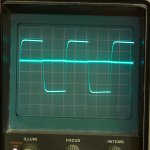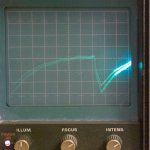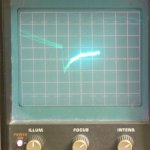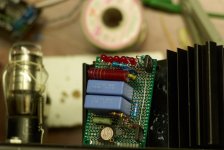-- But strap a 12V Zener from C2&R9 node to +Vo rail (cathode up) along upping the capacitance not to zap the JFET.
Salas, Good find.
That could very well be the cause, my raw capacitance in the LCLC is only 10+30 uF so it races down immediately with a current drain of 65 mA.
Would a diode work as well? Cathode to the plus, anode to C2&R9 node? That is how I would solve it. I must try it tomorrow.
albert
No, use Zener. Cathode to plus. Up C2 if you can also. But see with better raw filtering first.
I added the pre-regulator. (Fet with a 180k/4 uF filter; guarded with a reverse diode over the 180k). That is absolutely silent. Dead flat.
Still some reg-output flutter.
I think the reason is there is a loose connection in an amplification stage: the output jumps once in a while and the regulator voltage drops a little as response, just a little later.
Oh my. Having to revisit all solder joints ..
albert
Still some reg-output flutter.
I think the reason is there is a loose connection in an amplification stage: the output jumps once in a while and the regulator voltage drops a little as response, just a little later.
Oh my. Having to revisit all solder joints ..

albert
Could be, weird though. Some junction thermal cycle in the semis? But yes, first things first. Check the joints.
Could be, weird though. Some junction thermal cycle in the semis? But yes, first things first. Check the joints.
I will test with external 10k, 20 watt types (no output): one or two parallel.
Then I will detach the stages one by one (though I know it is not the input stage) but the problem starts at the second one (6SL7).
As regards semi's, a joint with different solder type might also be a problem. I have Sn-Ag 2% solder (from China, I bought it my self at a main distributor), but I found it is excellent for first soldering, once you rework it, it breaks apart (no flux left or so). This is just mine conjecture and I have not heard others talk about this strange phenomenon.
I am listening now to the RIAA stage: nice, lively. The 'noise' is far in the background and more or less disappears referenced to normal listening after half an hour. I also note the voltage goes up a few volts in this time period.
albert
That's a normal Vo drift up due to Tc in the junctions but no sudden jumps should be considered normal. Is there any extra rail decoupler cap on the 2nd stage?
That's a normal Vo drift up due to Tc in the junctions but no sudden jumps should be considered normal. Is there any extra rail decoupler cap on the 2nd stage?
Yes, I have 2n7 (mica) rail decoupler caps on input board and I have 5 uF that is the point where all the power comes from.
- Should I take out all caps? Or put a 4 ohms on this point?
- Issue is that I saw that the noise spectum rises with a 20 kHz signal and no caps . .

A trace with 500 Hz out to show the regulation (a few days ago) just input stage. Regulation trace is on 2 mV/cm. 4 volts out pp. Not bad really!
So no 5 uF yet connected.
The the current situation (indeed with 5uF):
 and non periodic it is:
and non periodic it is: 
It sags in a non-periodic timeline.
I took out tubes and it got better (that is: less frequent bumps). This is with only the first stage, one line is power out the other the preamp out, both 10 mV/cm. The noise comes from the regulator.
My board:

I am now replacing the jFET (went from BL to GR), and will take out the 5uF.
Update: Replaced the jFET
Last evening I stopped the vinyl, these background subsonic ticks were nerve-breaking!
I relistened today - worse in fact.
As the pictures show I had it all right at first, but while I readjusted for a higher voltage out, the problems started to occur: I tried various LCLC combinations, this must have caused some harm somewhere.
Oh well, after days of tinkering I'll go more traditional.Then next week I will recheck the shunt PCB on the lab supply.
albert
The caps on the load rails short the reg's zobel for AC. Either delete them or buffer them with series resistors to form RC. You got instability.
Salas,
I have 3,9 ohms and 1,2 uF. I thought this would be an adequate value. I understand the Zobel component values are very critical then. Probably it also depends on the shunt device transconductance (mine has a lower S - 3.9 versus 4.9 for the IRF840).
I have 3,9 ohms and 1,2 uF. I thought this would be an adequate value. I understand the Zobel component values are very critical then. Probably it also depends on the shunt device transconductance (mine has a lower S - 3.9 versus 4.9 for the IRF840).
- could I isolate the amp with an inductor, 200 ohms, 2 Henry, then 220 uF electrolytic and 5 uF MKP?
[/LIST
I tested it, it works, but I saw the electrolytic introduces its own noise spectrum!
Thanks for the support.
albert
Just buffer the 5uF on the load's rails with 1R in series. Your zobel values are not the problem. Your rails capacitor worsens the phase margin right near the point of full oscillation. Don't use inductance after the reg. Or any other networks for that matter.
Just buffer the 5uF on the load's rails with 1R in series. Your zobel values are not the problem. Your rails capacitor worsens the phase margin right near the point of full oscillation. Don't use inductance after the reg. Or any other networks for that matter.
Learning a lot!.
🙂
You think the power FET would not have been zapped then?
Zapped?? Just afraid. But you are right, it can't be the module.
I'll rework. I have now all caps with 1-5 ohms and will insert the shunt again later on.
I'll rework. I have now all caps with 1-5 ohms and will insert the shunt again later on.
I think I found out the reason for my persistent problems, problems that got worse and worse: one of my 6SL7's heaters was breaking down. It is now dead - though I measure a resistance on the tube, as soon as I apply a current it pops open and there is no current any more 😱
In fact not true 6SL7 but the russian 1578. I had them in series & with DC even though it was slow start. 🙄
I think: This caused the non-systematic drops in heater current and voltage sags.
I now have old ECC35 in the circuit, though a lot more noise, well sounding.
Have to revisit the heaters first of all though .... think I will go current source. Then restudy the Salas SSHV1
In fact not true 6SL7 but the russian 1578. I had them in series & with DC even though it was slow start. 🙄
I think: This caused the non-systematic drops in heater current and voltage sags.
I now have old ECC35 in the circuit, though a lot more noise, well sounding.
Have to revisit the heaters first of all though .... think I will go current source. Then restudy the Salas SSHV1
I am putting together a 26 preamp with transformers I have on hand, and I need to drop about 40V. Should I drop before the SSHV reg or use the reg to drop that much? Will it make the board too hot? Will a higher output impedance affect the performance of the reg?
Will order a better rated transformer but it would be nice to use what I have on hand for now.
Thanks
Charlie
Will order a better rated transformer but it would be nice to use what I have on hand for now.
Thanks
Charlie
Last edited:
Charlie,
if you have enough heatsinking for the 840 it will be fine.
The board doesn' t get hot.
if you have enough heatsinking for the 840 it will be fine.
The board doesn' t get hot.
- Home
- Amplifiers
- Power Supplies
- Simplistic mosFET HV Shunt Regs